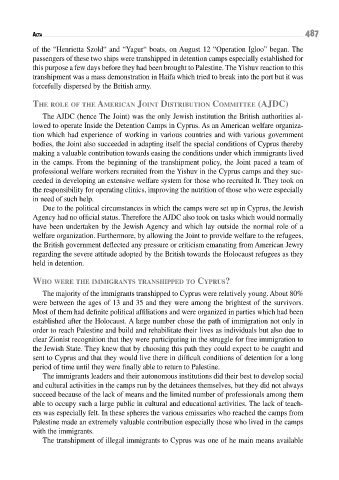Page 487 - Conflitti Militari e Popolazioni Civili - Tomo I
P. 487
487
aCta
of the “Henrietta Szold“ and “Yagur“ boats, on August 12 “Operation Igloo” began. The
passengers of these two ships were transhipped in detention camps especially established for
this purpose a few days before they had been brought to Palestine. The Yishuv reaction to this
transhipment was a mass demonstration in Haifa which tried to break into the port but it was
forcefully dispersed by the British army.
the rOle Of the aMerican jOint distributiOn cOMMittee (ajdc)
The AJDC (hence The Joint) was the only Jewish institution the British authorities al-
lowed to operate Inside the Detention Camps in Cyprus. As an American welfare organiza-
tion which had experience of working in various countries and with various government
bodies, the Joint also succeeded in adapting itself the special conditions of Cyprus thereby
making a valuable contribution towards easing the conditions under which immigrants lived
in the camps. From the beginning of the transhipment policy, the Joint paced a team of
professional welfare workers recruited from the Yishuv in the Cyprus camps and they suc-
ceeded in developing an extensive welfare system for those who recruited It. They took on
the responsibility for operating clinics, improving the nutrition of those who were especially
in need of such help.
Due to the political circumstances in which the camps were set up in Cyprus, the Jewish
Agency had no official status. Therefore the AJDC also took on tasks which would normally
have been undertaken by the Jewish Agency and which lay outside the normal role of a
welfare organization. Furthermore, by allowing the Joint to provide welfare to the refugees,
the British government deflected any pressure or criticism emanating from American Jewry
regarding the severe attitude adopted by the British towards the Holocaust refugees as they
held in detention.
whO were the iMMigrants transhiPPed tO cyPrus?
The majority of the immigrants transhipped to Cyprus were relatively young. About 80%
were between the ages of 13 and 35 and they were among the brightest of the survivors.
Most of them had definite political affiliations and were organized in parties which had been
established after the Holocaust. A large number chose the path of immigration not only in
order to reach Palestine and build and rehabilitate their lives as individuals but also due to
clear Zionist recognition that they were participating in the struggle for free immigration to
the Jewish State. They knew that by choosing this path they could expect to be caught and
sent to Cyprus and that they would live there in difficult conditions of detention for a long
period of time until they were finally able to return to Palestine.
the immigrants leaders and their autonomous institutions did their best to develop social
and cultural activities in the camps run by the detainees themselves, but they did not always
succeed because of the lack of means and the limited number of professionals among them
able to occupy such a large public in cultural and educational activities. The lack of teach-
ers was especially felt. In these spheres the various emissaries who reached the camps from
Palestine made an extremely valuable contribution especially those who lived in the camps
with the immigrants.
The transhipment of illegal immigrants to Cyprus was one of he main means available

